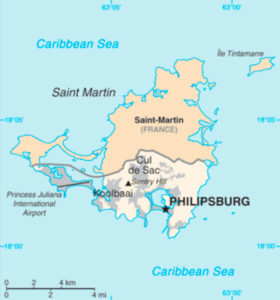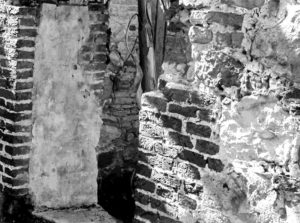 The island of St Maarten is divided roughly into two halves between the French and the Dutch. The Dutch side is part of the Netherlands Antilles. In the 18th century there was a sporadic Jewish population, mainly refugees from the English raid on St. Eustatius.
The island of St Maarten is divided roughly into two halves between the French and the Dutch. The Dutch side is part of the Netherlands Antilles. In the 18th century there was a sporadic Jewish population, mainly refugees from the English raid on St. Eustatius.
Jews first came to the island as refugees from the Spanish Inquisition, and the community grew during the 16th and 17th centuries. The first recorded Jew to settle on St. Maarten was Jacob Gomez who came from Curacao in 1735. He was followed by a Mrs. Silva, a widow who moved to the island with her son and daughter about 1740. Records also show a Jacob Dias Delgado who lived in St. Maarten in 1778.
Economic conditions between 1733 and 1783 showed a constant upward tendency for the Jews, who settled on the island during that time. Jacob Gomez de Mesquista is listed in the island census of April 5, 1791. The birth of Samuel Sasso is recorded in 1805. The archives also recorded the death in 1820 of Moses German of the “Portuguese rite,” (which means that he was Jewish) who was buried in the Jewish burial ground.
 In 1783, there were enough Jews there to ask permission to build a synagogue. It was thought that the St. Maarten Synagogue was built of wood with the eastern wall made of ballast stone, stones carried as ballast on ships arriving with very small cargo loads. A massive hurricane hit the island in 1819, leaving little standing. Notarial records of land sales and wills demonstrated the existence of Jewish life on the island from the 1820s through to the 1850s. Jews who were on the island after the synagogue was destroyed in 1819 still had a semblance of a community. Each person owned a portion of the synagogue and eventually sold or willed their portions.
In 1783, there were enough Jews there to ask permission to build a synagogue. It was thought that the St. Maarten Synagogue was built of wood with the eastern wall made of ballast stone, stones carried as ballast on ships arriving with very small cargo loads. A massive hurricane hit the island in 1819, leaving little standing. Notarial records of land sales and wills demonstrated the existence of Jewish life on the island from the 1820s through to the 1850s. Jews who were on the island after the synagogue was destroyed in 1819 still had a semblance of a community. Each person owned a portion of the synagogue and eventually sold or willed their portions.
The first notarial proof of the existence of the Jewish Burial Ground on St. Maarten was recorded on January 6, 1855, in a deed that referenced its northern boundary as the “Jew’s Burying Ground.” When the property changed hands in 1920, that notarial deed referenced the northern boundary as the Jewish Burial Ground measuring 140 feet long, an indication of the southern boundary as well as the size of the cemetery.
A disastrous hurricane and dwindling Jewish population brought an end to the community, which declined steadily until the 1960s when Jews from Curacao moved to the island in and established businesses. As the island’s tourism grew, a small local community developed that is joined by visitors. In 2009, a new synagogue emerged, to serve 300 Jewish residents and up to a total of around 1,000 or so during the tourist season.